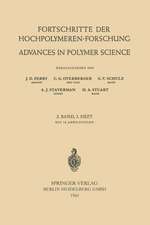Introduction to Phase Equilibria in Ceramic Systems
Autor Hummelen Limba Engleză Hardback – 31 mai 1984
| Toate formatele și edițiile | Preț | Express |
|---|---|---|
| Paperback (1) | 461.03 lei 6-8 săpt. | |
| CRC Press – 18 dec 2020 | 461.03 lei 6-8 săpt. | |
| Hardback (1) | 899.26 lei 6-8 săpt. | |
| CRC Press – 31 mai 1984 | 899.26 lei 6-8 săpt. |
Preț: 899.26 lei
Preț vechi: 1096.66 lei
-18% Nou
Puncte Express: 1349
Preț estimativ în valută:
172.11€ • 178.99$ • 144.02£
172.11€ • 178.99$ • 144.02£
Carte tipărită la comandă
Livrare economică 15-29 martie
Preluare comenzi: 021 569.72.76
Specificații
ISBN-13: 9780824771522
ISBN-10: 0824771524
Pagini: 400
Ilustrații: Illustrations
Dimensiuni: 156 x 234 x 25 mm
Greutate: 0.68 kg
Ediția:1
Editura: CRC Press
Colecția CRC Press
ISBN-10: 0824771524
Pagini: 400
Ilustrații: Illustrations
Dimensiuni: 156 x 234 x 25 mm
Greutate: 0.68 kg
Ediția:1
Editura: CRC Press
Colecția CRC Press
Public țintă
ProfessionalCuprins
PREFACE -- 1. INTRODUCTION AND DEFINITIONS -- I. Historical -- II. Literature Sources -- III. Statement of the Phase Rule and Definitions -- Problems -- References -- Reading List on Phase Equilibria -- 2. THE ONE COMPONENT SYSTEM -- I. Thermodynamic Basis of the Phase Diagram -- II. Application of the Phase Rule to the System H2 0 at Ordinary Temperature and Pressure -- III. Le Chatelier’s Principle and the Clausius-Clapeyron Equation -- IV. Metastability and Non-Equilibrium -- V. The Bridgman Ice Diagram and the Importance of -- Pressure; Polymorphism of Solids; Phase Diagram—Property Diagram -- VI. Examples of Real Systems VII. Summary -- Problems -- References -- 3. THE TWO COMPONENT SYSTEM -- I. Introduction -- II. The Binary Eutectic System -- III. Intermediate Compounds -- IV. Isothermal Analysis; Isothermal Evaporation -- V. Metastable Relationships in Simple Binary Systems -- VI. Complete or Continuous Solid Solution -- VII. Partial Solid Solution -- VIII. Phase Transitions in the End Members or Intermediate Solid Solutions; Combinations of Continuous and Partial Solid Solution; Exsolution -- IX. Complex Solid Solution Diagrams -- X. Liquid Immiscibility -- XI. Real Oxide Systems -- XII. Fluoride Model Systems Problems References -- 4. EXPERIMENTAL METHODS OF CONSTRUCTING PHASE DIAGRAMS -- I. Introduction -- II. Major Factors in Experimental Methods -- III. Glass Forming Systems vs. Non-Glass Forming Systems -- IV. Special Techniques -- V. Discussion and Evaluation of Experimental Pro-cedures on Real Systems -- VI. Thermodynamics and Computer Calculation -- Appendix A -- Appendix B References on High Pressure Methods and Materials -- Suggested Class Disscussions Which Can Enlarge the Understanding of Experimental Techniques -- References -- 5. TERNARY SYSTEMS W ITHOUT SOLID SOLUTION -- I. Introduction -- II. Isoplethal Analysis; The Equilibrium Crystallization Path in a Simple Eutectic Type System; Use of the Lever Rule -- III. Hie Influence of Binary Compounds on the Ternary System; Joins and Alkemades Lines; Composition or Compatibility Triangles; Crystallization Paths -- IV. The Influence of Ternary Compounds on the Ternary System; Crystallization Paths -- V. Polymorphism or Phase Transformations in Ternary Systems Without Solid Solution -- VI. Review and Summary of Factois Which Must Be Considered During Isoplethal Analyses -- VII. Liquid Immiscibility -- VIII. Isothermal Sections in Aqueous Systems; Isothermal Evaporation -- IX. Isothermal Sections in Ternary Oxide Systems -- X. Vertical Sections in Ternary Oxide Systems -- XI. Complex Ternary Systems -- XII. Real Ternary Systems Problems -- 6. NON-EQUILIBRIUM IN CERAMIC SYSTEMS -- I. General -- II. One Component Systems -- III. Two Component Systems -- IV. Three Component Systems -- Problems -- References -- 7. SOLID SOLUTION IN TERNARY SYSTEMS -- I. Introduction -- II. The Complete Solid Solution System; The Equilibrium Ciystallization Path -- III. Complete Solid Solution in One Binary System Combined With Two Simple Eutectic Systems; Isothermal Planes; Three Phase Boundary Lines; Quantitative Analysis of Crystallization Path (Isoplethal Analysis); Three Phase Triangles -- IV. Ternary Solid Solutions Crystallizing From Ternary Liquids; One Complete Solid Solution System, Two Partial Solid Solution Systems; Crystallization Path; Isothermal and Vertical Sections -- V. Solid Solution Systems With Three Phase Equilibria -- VI. Solid Solution Systems With Four Phase Equilibria -- VII. Additional Basic Solid Solution Systems -- VIII. Real Systems with Intermediate Compounds and Solid Solutions -- Problems -- References -- 8. QUATERNARY AND MULTICOMPONENT SYSTEMS -- I. Introduction; Quaternary Systems Without Solid Solution -- II. Crystallization Path in a Simple Quaternary Eutectic Type System; Isoplethal Analysis -- III. Method of Representing Relationships Between Quaternary Invariant Points -- IV. Solid Models of Real Quaternary Systems -- V. Solid Solution in Quaternary Systems VI. Multicomponent Systems -- References -- INDEX.
Descriere
This book provides a comprehensive, up-to-date introduction to phase equilibria in ceramic systems. It logically proceeds from one- and two-component systems through increasingly complex systems, enabling students to utilize the phase rule in real application.

























